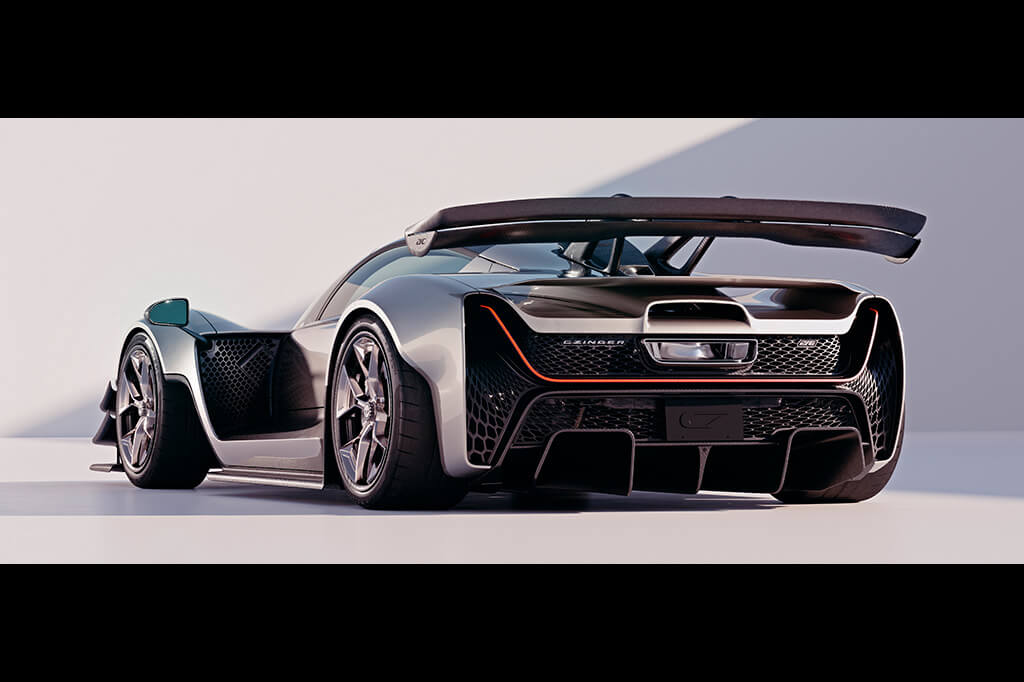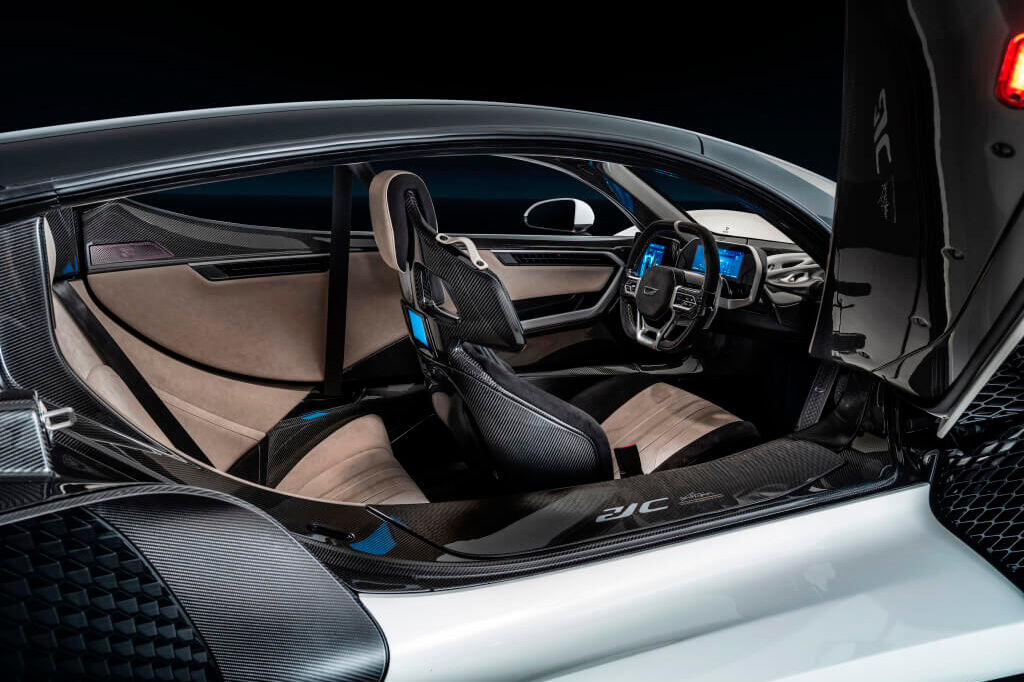Czinger 21C
Description
The Czinger 21C is a hybrid hypercar that was supposed to be unveiled at the 2020 Geneva Motor Show, which was canceled due to the pandemic. It was unveiled on March 11, 2020 in London during a special event.
Czinger Vehicles planned to produce 80 hypercars – 25 track and 55 road, at a price of 1.7 million US dollars for the base version.
Development
During the development and production of Czinger 21C, according to the company, advanced technologies were widely used, in particular industrial 3D printing. Thus, the body and chassis were made on a 3D printer.
Kevin Singer (the company is named after him), formerly known in narrow circles for the startup Divergent 3D, specializing in additive technologies. In 2015, Divergent 3D presented a prototype Blade hypercar with a body made from 3D printed elements. Conceptually, the Czinger 21C follows the Divergent Blade: it is a two-seat mid-engine hypercar with a tandem seating position, but the 21C has a more modern hybrid powertrain.
Engine
The car is equipped with three engines: a gasoline engine located longitudinally at the rear and driving the rear wheels through a gearbox, and two electric engines located at the front and driving the front wheels.
The internal combustion engine, which the company claims to have developed in-house (according to various sources, is derived from the Mitsubishi Lancer EVO engine), is a high-revving 2.88-liter V8 with a so-called flat-plane crankshaft and two turbochargers. Its maximum power is 950 hp. at 11000 rpm. This engine is the most powerful serial internal combustion engine in the world in terms of specific characteristics. Mated to a compact 7-speed sequential gearbox with a hydraulically controlled multi-plate clutch.
The electric power plant consists of two electric motors with a power of 150 kW (204 hp), installed at the front, which are powered by lithium titanate batteries located in the developed thresholds with a total capacity of 2 kWh. They are charged by a generator driven by an internal combustion engine (MGU) via a gear drive, as well as regenerative braking. Charging from an external power source is not provided.
The maximum total power of the power plant is 1250 hp, but as an option it is expected to increase the power to 1350 hp.
Dynamics
The dynamics of the hypercar are: acceleration to 100 kph – 1.9 s, to 300 kph – 8.5 s, to 400 kph – 21.3 s. The maximum speed is, according to the manufacturer, 452 km/h and 380 kph for the track model called “Lightweight Track”. As of the end of 2021, the manufacturer’s website lists the maximum speed of the base model as 405 kph.
The hypercar set a lap record at the Laguna Seca circuit – 1:25.45 s, and then at the Circuit of the Americas, where it drove the 5.5-kilometer track in 2:11.33 s, 6 seconds ahead of the previous record holder in the road car class – a hypercar McLaren P1.
Chassis
Kevin Zinger is a big fan of cycling and motorcycles. Therefore, he believes that a central driving position is optimal. So, the passenger seat is located behind the driver's seat.
The basis of the body with tandem seating for the driver and the only passenger is a carbon fiber monocoque, from which are numerous amplifiers, seat frames, elements of internal and external cladding. Many elements of the body and chassis of the Czinger 21C are made by 3D printing from a powdered alloy of aluminum and titanium. The declared dry weight of the Czinger 21C is 1183 kg (curb – 1250 kg), the track version “Lightweight Track” – dry weight – 1151 kg (curb – 1218 kg). The sweeping silhouette delivers 638 kg of downforce at 161 kph (100 mph) and 2,552 kg at 322 kph (200 mph).
Interior
The interior of the car is designed extremely ascetically: there is no dashboard as such, instead there are two touch screens. Boarding occurs through the only right-hand guillotine-type door. For the passenger, the road version of the Czinger 21C has a small entertainment screen mounted on the back of the driver's seat.
Sources
Specification
| Bodywork | |
|---|---|
| Presentation | |
| Years of production |
2021-
|
| Body type |
купе
|
| Number of doors |
1
|
| Number of places |
2
|
| Engine 1 | |
|---|---|
| Engine type |
гибрид (HEV)
|
| Engine location |
центральное, продольное
|
| Cylinders |
V8
|
| V-angle |
90
|
| Capacity (cc) |
2882
|
| Power output (hp / kW /) |
950 /
699 /
|
| at rpm |
11000
|
| Torque (N·m) |
746
|
| Number of valves |
4/32
|
| Valvetrain |
DOHC
|
| Block material |
алюминиевый сплав
|
| Flat-plane crankshaft |
Да
|
| Fuel system |
впрыск
|
| Turbocharger |
2
|
| Engine 2 | |
|---|---|
| Number of electric motors |
2
|
| Power output (hp / kW /) |
204 /
150 /
|
| Battery Type |
LTO
|
| Battery voltage (V) |
800
|
| Summary | |
|---|---|
| Power output (hp / kW /) |
1250 /
932 /
|
| Torque (N·m) |
1439
|
| Specific | |
|---|---|
| Specific output (hp/litre) |
329,63
|
| Specific output (hp/tonne) |
1000,00
|
| Specific output (kg/hp) |
1,00
|
| Specific torque (N•m/litre) |
258,85
|
| Specific torque (N•m/tonne) |
1151,20
|
| Transmission | |
|---|---|
| Driven wheels |
полный
|
| Clutch |
двухдисковое
|
| Gearbox |
роботизированная
|
| Number of speeds |
7
|
| Suspension | |
|---|---|
| Front suspension |
независимая
|
| Rear suspension |
независимая
|
| Elastic elements in front |
пружины
|
| Elastic elements in rear |
пружины
|
| Front anti-roll bar | |
| Rear anti-roll bar |
| Steering | |
|---|---|
| Steering type |
шестерня-рейка
|
| Power steering |
электрический
|
| Brakes specs | |
|---|---|
| Brakes front |
дисковые вентилируемые
|
| Brakes rear |
дисковые вентилируемые
|
| Front brake diameter (mm) |
410
|
| Rear brake diameter (mm) |
390
|
| Number of caliper pistons (front/rear) |
6/4
|
| Anti-lock braking system |
да
|
| Dimensions and weight | |
|---|---|
| Body |
монокок с панелями
|
| Body material |
углеволокно, титан
|
| Width (mm) |
2050
|
| Dry weight (kg) |
1183
|
| Curb weight (kg) |
1250
|
| Performance specs | |
|---|---|
| Fuel type |
бензин
|
| Dynamic specs | |
|---|---|
| Acceleration 0-100 kph (s) |
1,9
|
| Acceleration 0-300 kph (s) |
8,5
|
| Acceleration 0-400 kph (s) |
21,3
|
| Acceleration 0-402 m (1/4 mile) (s) /kph/ |
8,1 /
|
|---|
| Braking distance 100-0 kph (m) |
31
|
|---|
| Top speed (kph) |
405
|
|---|---|
| Top speed (mph) |
252
|



